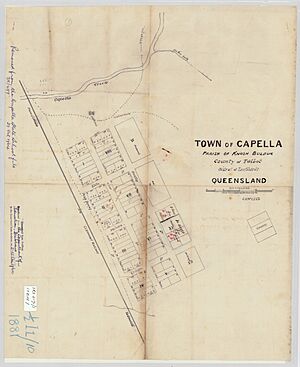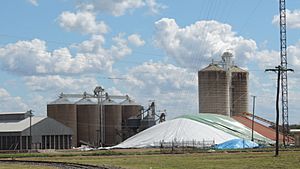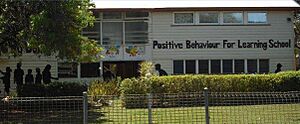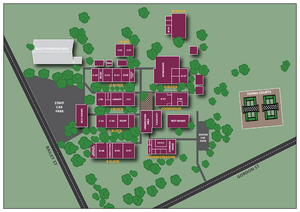Capella, Queensland facts for kids
Quick facts for kids CapellaQueensland |
|||||||||||||||
|---|---|---|---|---|---|---|---|---|---|---|---|---|---|---|---|
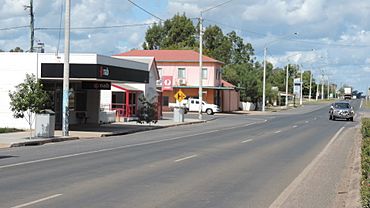
The Gregory Highway is the main street in Capella, 2016
|
|||||||||||||||
| Population | 974 (2021 census) | ||||||||||||||
| • Density | 103.6/km2 (268/sq mi) | ||||||||||||||
| Postcode(s) | 4723 | ||||||||||||||
| Area | 9.4 km2 (3.6 sq mi) | ||||||||||||||
| Time zone | AEST (UTC+10:00) | ||||||||||||||
| Location |
|
||||||||||||||
| LGA(s) | Central Highlands Region | ||||||||||||||
| State electorate(s) | Gregory | ||||||||||||||
| Federal Division(s) | Flynn | ||||||||||||||
|
|||||||||||||||
Capella is a small country town in the Central Highlands Region of Queensland, Australia. It is also a locality, which is like a local area. In 2021, about 974 people lived in Capella.
Contents
Where is Capella?
Capella is located between the towns of Emerald and Clermont. The main road, called the Gregory Highway, runs right through Capella. This highway is also known as Peak Downs Street and is the town's main street.
Getting Around Capella
A railway line also runs through Capella, next to the highway. The Capella railway station is part of a line connecting Emerald to Blair Athol. This line is a branch of the larger Central Western railway line.
Capella Creek flows through the northern part of the area. This creek eventually joins the Nogoa River, which then flows into the Fitzroy River and finally reaches the Coral Sea.
Capella Airport
Even though it's called Capella airport, it's actually located in the nearby area of Hibernia. It has a gravel runway that is about 985 meters long. The airport is only used during the day because it does not have lights. The local council manages it.
Capella's History
Capella was settled in the 1860s on the traditional land of the Wangan people. Early settlers were encouraged by good reports from explorer Ludwig Leichhardt.
The town and Capella Creek were named after the star Capella. A surveyor named Charles Frederick Gregory likely named the creek in 1862. This was after copper was found nearby at Copperfield.
For many years, Capella was a small stop between Emerald and Clermont. This changed when a railway line was built connecting the two larger towns in 1882. A post office also opened in Capella on December 5, 1882.
Early Buildings and Services
In 1883, a Presbyterian Church and school were built. The Capella Provisional School opened on August 29, 1883. It had 35 students by 1884. In 1900, it became Capella State School. A pre-school was added in 1978, and a secondary department in 1984. This secondary department later became Capella State High School in 1989.
Farmers started growing crops and dairying in Capella around 1883. A butter factory was built in 1900 to support the dairy industry.
By the late 1890s, Capella was growing. New shops opened, and hotels were renovated. The Holy Spirit Anglican Church opened in 1907.
Growth in the 20th Century
Capella continued to grow steadily in the early 1900s. Many new buildings were constructed in the 1920s. These included a café, a bakery, and a new Roman Catholic church called St Joseph's. A new hall, a movie theatre, and Country Women's Association clubrooms were also built.
In 1927, Capella became the main town for the Shire of Peak Downs local government. A new Shire Hall was built in 1936. The town also got better streets and footpaths.
Electricity came to Capella in December 1954. Other services like town water arrived in 1962, and mains sewerage in 1982.
Farming and Mining Changes
In the 1950s, a project tried to grow large amounts of grain in the area. This project didn't last, but it introduced new crops like sunflower and sorghum.
The Capella Hotel was built in 1955. The local council decided to build it because the previous hotel had burned down. This was unusual, as councils don't usually build hotels.
In the 1960s, the Brigalow Development Scheme cleared large areas of brigalow scrub. This created new farmland for growing grain and cereal crops. Big storage buildings for these crops were built in 1964. More farming families moved to Capella, and new facilities opened, like an agricultural show, Girl Guides, and a swimming pool.
Coal was found near Tieri in 1982, about 36 kilometers east of Capella. A large open-cut mine was developed. This mine helped the local economy. In the 1980s, Capella gained new buildings like the Capella Cultural Centre and a pioneer village.
In 2003, Capella's water supply was secured with a pipeline to Tieri. In 2008, the Shire of Peak Downs joined with other areas to form the Central Highlands Regional Shire.
Capella's Economy
Capella is an important service town. It supports the large coal-mining industry nearby. It also helps local farmers and people who raise livestock.
GrainCorp has a large storage area next to the Capella railway station. Here, crops like sorghum, wheat, chickpea, and barley are collected and stored.
Education in Capella
Capella has two main schools for young people.
Capella State School
Capella State School is a government primary school for students from Prep to Year 6. It is located at 41 Huntley Street. In 2018, the school had 171 students.
Capella State High School
Capella State High School is a government secondary school for students from Year 7 to Year 12. It is located at 35-45 Gordon Street. In 2018, the high school had 110 students. It also offers a special education program.
Community Facilities
Capella has many important facilities to help its residents.
- Capella Police Station is at 35 Huntley Street.
- Capella Fire Station is at 18 Conran Street.
- The Capella SES Facility is at 20 Hibernia Road. The SES helps people during emergencies like floods or storms.
- Capella Outpatients Clinic is at 5 Slider Street. This clinic provides health services.
- Capella Ambulance Station is at 9 Gordon Street.
- The Peak Downs Shire cemetery is in Walsh Street. It has a memorial for people buried in the first Capella Cemetery from 1865 to 1899.
What to Do in Capella
Capella offers various places for recreation and community activities.
Capella Library
The Central Highlands Regional Council runs the Capella Library at 83 Peak Downs Street. It's a great place to find books and learn.
Capella Cultural Centre
The Capella Cultural Centre is an entertainment venue at 89 Peak Downs Street. It can seat up to 500 people. It hosts movies, conferences, and shows by touring performers.
Bridgeman Park Sporting Complex
Bridgeman Park Sporting Complex is at 23 Hibernia Road. It has many sports fields, including those for polocrosse, football, and cricket. It also has a covered arena, stables, and camping facilities. People enjoy activities like campdrafting, rugby league, rugby union, and cricket here.
Capella Aquatic Centre
The Capella Aquatic Centre is a swimming pool and fitness complex at 107 Peak Downs Street. It has swimming pools, waterslides, a gym, and squash courts. There's also a cafe and barbecue area.
Community Groups and Churches
The Capella branch of the Queensland Country Women's Association (QCWA) meets at their hall at 87 Peak Downs Street.
Capella has several churches:
- Holy Spirit Anglican Church is at 32 Conran Street.
- St Joseph's Catholic Church is at 59 Abor Street.
- Capella Uniting Church is at 43 Huntley Street.
Events in Capella
Capella hosts several exciting events throughout the year.
- An annual campdraft event takes place in March. Campdrafting is a sport where a rider on horseback guides a cattle beast around a course.
- The Capella Show is held every May. It's a fun event with displays, competitions, and entertainment.
- The Capella Polocrosse Carnival happens every July. Polocrosse is a team sport played on horseback, combining polo and lacrosse.
- The Capella Cattledogs are the local rugby union team. They play in the Central Highlands Rugby Union competition from March to September.
- The Peak Downs Pirates are the local rugby league team. They compete in the Central Highlands Rugby League competition.
Local Attractions
Capella Pioneer Village
Capella Pioneer Village is a museum located in Pioneer Street. It is in Australia's largest restored homestead built with a special "drop-plank" method. The village has over 5,000 historical items. These items are grouped into different exhibits, showing what life was like in the past.
Images for kids



